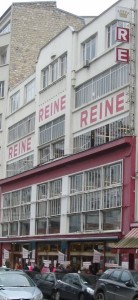Waterproblems or Paris in Summer
Paris kann im Sommer doch recht heiß werden und wenn man so vom Eiffelturm zu Notre Dame läuft (oder woanders hin), dann kommt schnell das Bedürfnis nach Flüssigkeit auf. Im Prinzip ist das kein Problem, denn es gibt jede Menge Bars und Cafés die hier gerne Getränke aller Art servieren. An einem heißen Tag geht das natürlich schnell ins Geld.
Günstiger ist da die Flasche Wasser vom Lebensmittelgeschäft, die es nach wie vor an jeder Ecke gibt oder gleich von einem der größeren oder kleineren Supermärkte.
Aber es geht auch billiger, kostenlos, um genau zu sein.
 Mit den Fontaine Wallace.
Mit den Fontaine Wallace.
Diese Brunnen stehen in fast allen Pariser Arrondissements (dieser Wikipedia-Artikel listet auch die Standorte auf) und was dort zwischen den Karyatiden fließt ist Trinkwasser. Mehr als einen Becher zum drunterhalten braucht man also nicht.
(Der einzige Nachteil ist, daß das Pariser Trinkwasser meist mehr oder weniger gut gechlort ist, was nicht schädlich, aber eben geschmacklich etwas unangenehm ist.)
Summer can be quite hot in Paris and when you stroll from the Eiffel Tower to Notre Dame (or somewhere else) you quickly feel the need for some liquid. Sure, there are plenty of Bars or Cafés who are willing to sell you any hot or cold drink you want. Only on a hot day that means you have to spend a lot of money.
If you buy a bottle of water at one of the many small groceries it’s cheaper and even cheaper is it when you find one of the smaller or bigger supermarkets.
But you can have it still cheaper, for free.
Just find a Fontaine Wallace.
There are several of those in nearly all arrondissements (this wikipedia articel contains a list of all fountains) and what runs between the caryatides is normal tap water.You just need a cup to catch the water.
(The tapwater in Paris has perfect drinking qualities, the only thing that can disturb is the taste of chlorine, sometimes it’s more, sometimes it’s less.)
Das allerdings löst nur das halbe Problem, denn Wasser was in den Körper hinein geht, will auch wieder raus. Und da wird es dann richtig spannend…
Im Café oder in der Bar ist es natürlich kein Problem, die haben Toiletten, wenn auch nicht immer zum Sitzen und häufig klein. Außerdem verlangen manche Gaststätten tatsächlich Geld dafür. (Als Gast der etwas konsumiert hat fragt man in der Regel an der Theke nach „une piece pour les toilettes, s’il-vous plait“ und bekommt dann normalerweise die passende Münze.)
Abgesehen davon wird es schon schwierig, die großen Kaufhäuser haben Toiletten, das sind aber genau vier (BHV, Galeries Lafayette, Le Bon Marché und Printemps), Supermärkte oder kleinere Kaufhäuser wie Monoprix haben in der Regel keine. Einkauszentren sind im Zentrum von Paris eher dünn gesät. In den Museen wird man fündig, aber häufig erst nach der Kasse.
This of course is only half of the problem. Water that goes in wants to go out after some time. And in Paris this can be the crucial point…
Of course a Café or a Bar will have toilets (often small and not always to sit). But some might want to charge you for using them. (As a paying customer you can usually ask the waiter at the counter for „une piece pour les toilettes, s’il-vous plait“ and get a coin.)
Apart from that it’s getting more complicated, only the for big department stores (BHV, Galeries Lafayette, Le Bon Marché und Printemps) have facilities, supermarkets or smaller stores as Monoprix don’t. Shopping Malls in the center of Paris don’t come in big numbers. And in museums it’s often after the ticket box.
 Natürlich gibt es auch dafür eine Lösung. Zumindest in der Theorie.
Natürlich gibt es auch dafür eine Lösung. Zumindest in der Theorie.
Nachdem die Feministinnen dafür gesorgt haben, daß die früher zahlreich vertretenen Pissoires abgeschafft werden mußten wurden stattdessen diese vollautomatischen und von beiden Geschlechtern zu benutzenden Toilettenhäuschen aufgestellt. Und seit einigen Jahren ist die Benutzung sogar kostenlos.
Da sie sich nach jeder Benutzung automatisch reinigen muß man sich wegen der Hygiene auch keine Sorgen machen. Allerdings dauert der Reinigungsprozess und wenn eine ganze Reisegruppe vor einem Häuschen Schlange steht, dann dauert das. Denn die Kabinen reinigen sich wirklich nach jedem Benutzer. (Was auch nicht vorgesehen ist, ist eine Trockung. Gerade im Herbst und Winter ist das dann zwar alles sauber, aber nass und kalt….)
Of course there is a solution, at least theoretically.
Since the feminists made sure that the old urinals had to go those fully automatized unisex toilet boxes were placed all over Paris. And for some years they are even free.
No worries regarding hygienics, because the boxed do an automatic cleaning cycle after each use. This cleaning cycle, of course takes some time. And if a tourist group wants to use one of the boxes that will take a good part of the afternoon. Because there is no way do shorten the cleaning cycle. (Another thing that has not been thought of is a possibility to dry the interior after the cleaning. So expecially in autumn and winter it may be clean, but it definitely is cold and wet…)

Während der Reinigung zeigt einem die Kabine übrigens das „besetzt“ Zeichen.
Und noch eine kleine Widrigkeit tut sich auf (man beachte die kleine Schrift auf dem weißen Knopf, ein klick aufs Bild zeigt eine größere Version), die Dinger haben tatsächlich… Öffnungszeiten. Bei den meisten ist schon zwischen 19.00 und 20.00 Uhr Schluß, nach 22.00 Uhr ist endgültig Sense.
While the cabin is cleaning it will show itself als „occupied“.
But even if that is not the case there is another tiny downside (klick on the pic to enlarge it, then read the writing on the white button), the boxes have… closing hours. Usually between 7 p.a. and 8 p.m., after 10 p.m. it’s over.
 Und sollte es mal tagsüber sein, auch keine lange Menschenschlange davor stehen… dann zeigen sich die Kästen als echte Maschinen und zeigen das an, was wir von den Bahnautomaten auch gut kennen: „Außer Betrieb“. :o)
Und sollte es mal tagsüber sein, auch keine lange Menschenschlange davor stehen… dann zeigen sich die Kästen als echte Maschinen und zeigen das an, was wir von den Bahnautomaten auch gut kennen: „Außer Betrieb“. :o)
But there are moments when it’s daytime, not occupied and no long queues waiting… then the boxes will show you that they are real machines and show what we probably know well from any ticket maschine: „Out of order“. :o)
(Aber im Moment werden alle diese Toiletten durch neuere und tollere ersetzt. Vielleicht funktionieren die dann auch mal zuverlässig.)
(They’ve started to replace the old toilets by new and better ones. Maybe those are able to work reliably.)
 Also mußte ich vom letzten Paris Besuch etwas Stoff mitbringen.
Also mußte ich vom letzten Paris Besuch etwas Stoff mitbringen.
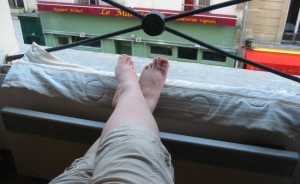



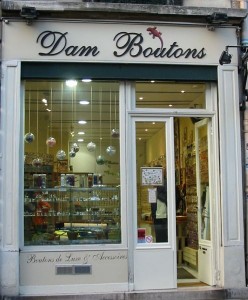
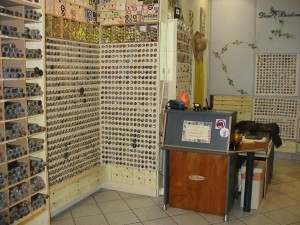
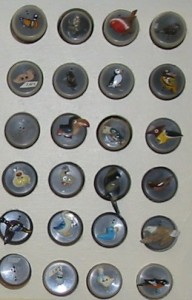




 Auffällig waren zunächst einmal die vielen schwarzen Kleider, verschiedene Schnittformen, aber immer etwa knielang und weder eng noch extraweit.
Auffällig waren zunächst einmal die vielen schwarzen Kleider, verschiedene Schnittformen, aber immer etwa knielang und weder eng noch extraweit. Und natürlich war ich auch neugierig, ob der überall angepriesene Trend zum Maxikleid auch sichtbar wäre. (Hier ein Beispiel aus der aktuellen Juli Burda.)
Und natürlich war ich auch neugierig, ob der überall angepriesene Trend zum Maxikleid auch sichtbar wäre. (Hier ein Beispiel aus der aktuellen Juli Burda.)